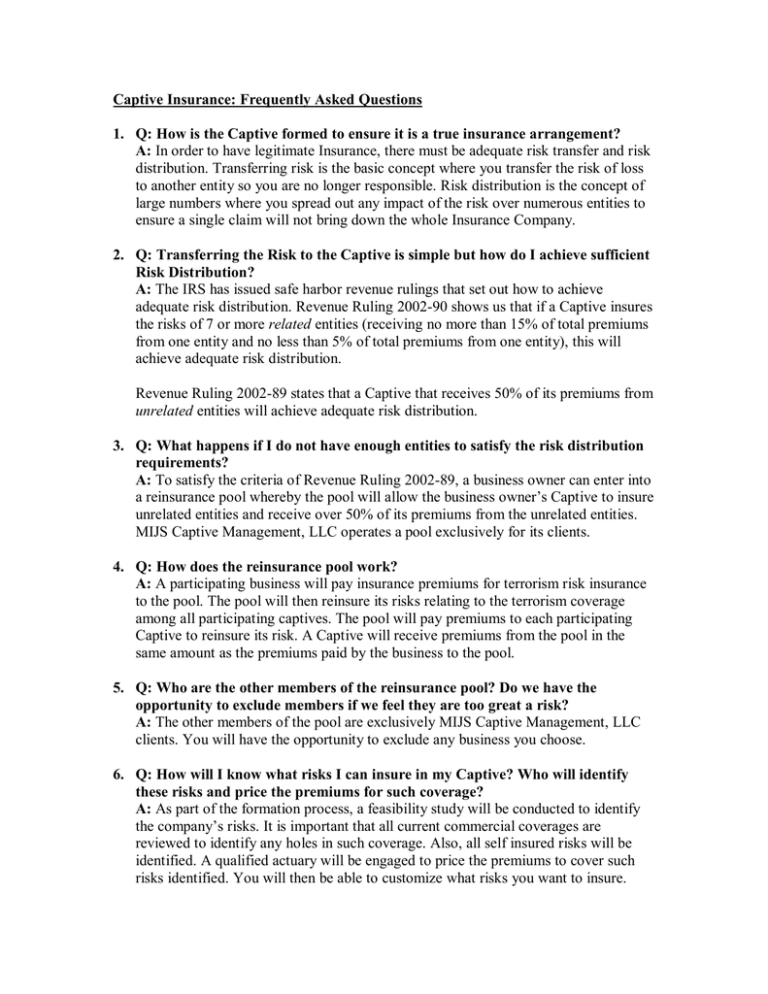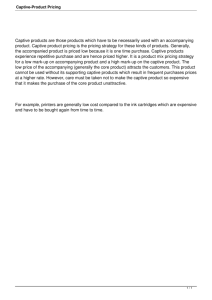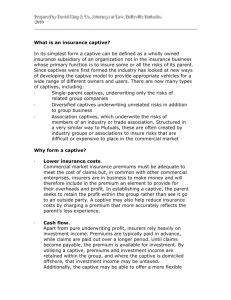Captive Insurance: Frequently Asked Questions 1. Q: How is the
advertisement

Captive Insurance: Frequently Asked Questions 1. Q: How is the Captive formed to ensure it is a true insurance arrangement? A: In order to have legitimate Insurance, there must be adequate risk transfer and risk distribution. Transferring risk is the basic concept where you transfer the risk of loss to another entity so you are no longer responsible. Risk distribution is the concept of large numbers where you spread out any impact of the risk over numerous entities to ensure a single claim will not bring down the whole Insurance Company. 2. Q: Transferring the Risk to the Captive is simple but how do I achieve sufficient Risk Distribution? A: The IRS has issued safe harbor revenue rulings that set out how to achieve adequate risk distribution. Revenue Ruling 2002-90 shows us that if a Captive insures the risks of 7 or more related entities (receiving no more than 15% of total premiums from one entity and no less than 5% of total premiums from one entity), this will achieve adequate risk distribution. Revenue Ruling 2002-89 states that a Captive that receives 50% of its premiums from unrelated entities will achieve adequate risk distribution. 3. Q: What happens if I do not have enough entities to satisfy the risk distribution requirements? A: To satisfy the criteria of Revenue Ruling 2002-89, a business owner can enter into a reinsurance pool whereby the pool will allow the business owner’s Captive to insure unrelated entities and receive over 50% of its premiums from the unrelated entities. MIJS Captive Management, LLC operates a pool exclusively for its clients. 4. Q: How does the reinsurance pool work? A: A participating business will pay insurance premiums for terrorism risk insurance to the pool. The pool will then reinsure its risks relating to the terrorism coverage among all participating captives. The pool will pay premiums to each participating Captive to reinsure its risk. A Captive will receive premiums from the pool in the same amount as the premiums paid by the business to the pool. 5. Q: Who are the other members of the reinsurance pool? Do we have the opportunity to exclude members if we feel they are too great a risk? A: The other members of the pool are exclusively MIJS Captive Management, LLC clients. You will have the opportunity to exclude any business you choose. 6. Q: How will I know what risks I can insure in my Captive? Who will identify these risks and price the premiums for such coverage? A: As part of the formation process, a feasibility study will be conducted to identify the company’s risks. It is important that all current commercial coverages are reviewed to identify any holes in such coverage. Also, all self insured risks will be identified. A qualified actuary will be engaged to price the premiums to cover such risks identified. You will then be able to customize what risks you want to insure. Many professionals who promote Captive planning do not involve actuaries or liability attorneys in order to accurately assess the true risks of the Company. It is imperative that these professionals be engaged to ensure the legitimacy of the Captive planning. 7. Q: Does my company need to pay the full $1.2M in premiums a year to the Captive? What is the minimum amount my company can pay for the Captive planning to make sense? What if my company can pay over $1.2M in premiums? A: $1.2M is the maximum that a Captive, which elects 831(b) status, can receive tax free. A company does not need to pay the full amount. For the Captive program to make economic sense, a business owner should plan to pay a minimum of $500,000 in premiums a year to the Captive; however, premium amounts will be determined on a year to year basis. A business owner is not required to make a premium payment to the Captive every year and can even take up to three years off from making payments if needed. Additionally, the Captive can be shut down at any time if the business owner can no longer utilize it. If a company can pay more than $1.2M in premiums, multiple Captives can potentially be set up (subject to the Internal Revenue Code control group rules). NOTE- The Captive insures legitimate risks, therefore even if a company has the ability to pay up to or greater than $1.2M in premiums, the company needs to have sufficient risk to justify such premium amounts. 8. Q: Are there any requirements as to what type of entity the Insured must be (CCorp, Partnership, LLC)? Does the Captive have to be a C-Corp? A: The Insured can be any type of business entity. The Captive must be a CCorporation. 9. Q: Who can be the owner of the Captive? Is the Insured the owner? Can the Shareholders of the Insured be the owners? Can key employees or other individuals or entities be an owner? A: Anyone can own the Captive. Ownership is extremely flexible and can be structured in accordance with the goals of the individuals creating the Captive. The Insured entity itself can be the Owner. The underlying Shareholders, Partners, Members, etc. of the Insured can be the owners of the Captive and in any percentage they chose. Trusts or other investment vehicles can be an owner outright or in conjunction with an individual. Trust ownership (in whole or in part) is a tremendous estate planning and asset protection tool. All the funds being paid to the Captive will be removed from the business owner’s estate and will remain in Trust estate tax free for future generations. The Captive funds will also be creditor protected by the Trust. Additionally, Captives can be utilized for retirement plans and can also be owned by Employees to provide a non qualified compensation plan. 10. Q: Are there any limitations as to the type of insurance risks or liabilities the Captive can insure? A: Due to its size and scope, a Captive can not provide Workers Compensation Insurance, Health Insurance and other certain commercially procured and state regulated coverages. A Captive can cover anything considered a “Llyod’s” risk. 11. Q: What are some examples of policies written by a Captive? A: Hail Damage; Defense Costs, Business Interruption; Professional liability Gap Coverage; Electronic Data Loss; Contractual Liability; General Liability Gap; Cyber Liability; Environmental/Pollution Liability; Excess Environmental Liability; Labor Shortage/Strike Loss Reimbursement; Employment Practices; Employee Dishonesty; Patent Infringement/Intellectual Property; General Liability Gap; General Liability Retention; Property Management Professional; Professional Misconduct; Product Recall; Billing Audit Liability; Product Liability; Directors and Officers Liability; Punitive Damages; Loss of Key Employee; Deductible Reimbursements (Property, Workers Comp, General Liability, Product Liability) 12. Q: Would the coverage procured from the Captive replace any of my existing commercial coverages? A: No. The Captive coverages are intended to supplement current commercially procured coverages. 13. Q: What is the role of an agent or broker when setting up a Captive? A: The commercial agent or broker is an important aspect of the Captive planning. They will help identify risks that are under insured or risks which can not be covered in the commercial market. The agent or broker will be integral in helping to structure the Captive program. 14. Q: What can be done with the premiums received by the Captive? Can these funds be invested? Are their limitations as to the investments? How are investments taxed to the Captive? A: The only limitation is that $250,000 must remain in cash or cash equivalents at all times. The rest of the funds can be freely invested. The State Departments of Insurance advise that a Captive be well diversified and not heavily invested in one asset class. Also, the Captive owner needs to always remember that while a policy is outstanding, a claim can be made at any time and the Captive funds will need to be readily available to pay such a claim. As a reminder, all premiums received by the Captive (under $1.2M) are received income tax free. A Captive is a C-Corporation. Any investment income will be taxed to the Captive at the C-Corp level at corporate tax rates, currently 35% (there are investment advisors who are able to invest the funds in a tax efficient manner to reduce any investment tax liability). The Captive is able to distribute its surplus to its shareholders. These funds will almost always be taxed to the shareholder at qualified dividend rates (20%-23.8% currently; compared to about 40%+ tax rate imposed on a business owner if it were to be distributed from the operating entity). 15. Q: Are there additional capital contributions required beyond the $250,000.00 initial capital? Does the $250,000 initial capital have to be in cash? A: The only time additional capital may be needed is if a large claim is made that brings the Company’s equity below $250,000 and therefore additional capital would be required to ensure the Company does not fall below the statutory requirement of maintaining $250,000 in equity. Initially, it is advised that the owners capitalize the Captive with $280,000 as until the first year premiums are earned, the expenses of the first year of operation will reduce the Captive’s $250,000 capital and therefore the Captive would not be compliant with the requisite State statute. Capitalizing the Captive with $280,000 gives the company a small cushion to ensure the Captive stays in compliance. The initial Capital can be in the form of cash or a letter of credit. 16. Q: What happens if I sell my company and I have a Captive set up? What happens to the Captive? A: The Captive is a separate Company from your operating business. You have the ability to negotiate with the buyer as to how the Captive will be handled. You may choose to sell the Captive along with your business, keep it running or shut it down as the buyer probably won’t want to pay premiums to it any longer. 17. Q: What is the difference between a Captive domiciled in a US jurisdiction (such as Delaware) versus a company domiciled offshore (such as in the Cayman Island) A: Captives formed in a U.S. Jurisdiction are subject to regulation by the Department of Insurance of the State in which it is formed. Typically, all U.S. States have strict capital requirements to ensure the Captive’s viability and also have strict yearly filing requirements to ensure the Captive is running correctly. Offshore Captives are less regulated and have less capital requirements. Often, formation and management of a Captive Offshore is cheaper than using a U.S. Jurisdiction, however, Offshore Captives can be subject to greater scrutiny than a U.S. based Captive as the U.S. based Captive is under the eye of a State Department of Insurance which gives greater legitimacy to its structure. 18. Q: Who handles the insurance claims made against the Captive? Who manages the Captive and ensures it functions correctly and remains in compliance with all state and federal laws? A: The Captive Manager will coordinate and handle all claims made. Additionally, the Manager will ensure the Captive functions correctly and is up to date with all state and federal regulatory filings. The Manager will coordinate with all third party service providers and keep the Captive Owner informed and up to date. 19. Q: What is an estimate of the typical ongoing fees to maintain the Captive? A: Approximately $85,000. This includes management fees, state renewal fees, annual premium tax of $5,000, actuarial fees, annual Audit and Tax Return fees, pooling fees, registered agent fees, and a Department of Insurance exam fee about once every 5 years.





